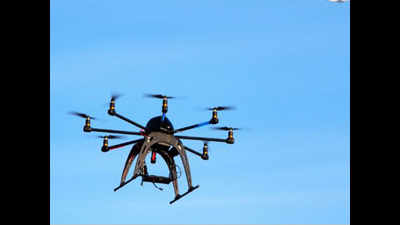- News
- City News
- nagpur News
- National Tiger Conservation Authority gets defence ministry nod to use drones in tiger reserves
Trending
This story is from January 19, 2017
National Tiger Conservation Authority gets defence ministry nod to use drones in tiger reserves
In a major move to protect tigers, Melghat is among the 13 tiger reserves in the country to get approval from director general of civil aviation (DGCA), ministry of home affairs (MoHA) and ministry of defence (MoD) to implement monitoring with the help of drones, commonly known as unmanned aerial vehicles (UAVs).

(Representative image)
NAGPUR: In a major move to protect tigers, Melghat is among the 13 tiger reserves in the country to get approval from director general of civil aviation (DGCA), ministry of home affairs (MoHA) and ministry of defence (MoD) to implement monitoring with the help of drones, commonly known as unmanned aerial vehicles (UAVs).
The other 12 tiger reserves include Corbett, Dudhwa, Ranthambore, Panna, Similipal, Nagarjunasagar-Srisailam, Bandipur, Satyamangalam, Parambikulam, Kaziranga, Namdapha, and Sundarbans.
The ‘E-Bird technology for tiger conservation: Development and integration of unmanned aerial vehicles (UAVs)’ project will be jointly implemented by National Tiger Conservation Authority (NTCA) and Wildlife Institute of India (WII).
Melghat chief conservator of forests (CCF) & field director Dinesh Kumar Tyagi said NTCA has directed us to gear up frontline staff for training capacity building to use the new technology, besides nominating a nodal officer to coordinate with NTCA and WII, who will extend full cooperation.
Tyagi said three months ago that there was a trial run of drones from Narnala wildlife sanctuary atop. The UAV was run by private parties and it was found to very useful, especially in rugged and undulating terrain like Melghat.
“The drone will act as an ‘eye in sky’ and a binocular in hand. The UAV will help better protection and conservation of tigers and its prey base along with information about forest fires and other biodiversity in Melghat,” Tyagi said.
The field director said drones can fly in riskier and treacherous areas and due to their aerodynamic and size they are able to fly at lower altitudes and collect precise real time information than manned aircraft or satellite.
NTCA sources said the ministry will send different kinds of equipment in the drones, including thermal cameras and mapping cameras. Each drone is expected to cost Rs3-5 lakh.
According to the 2014 estimates released in January 2015, India is home to 2,226 tigers, which is 70% of world’s wild tigers. “The increase in tiger numbers, coupled with staff crisis, is one of the main reasons for the MoEFCC taking to drones to ensure the safety and security of tigers.
“The other advantages of drones are that these are light weight, easy to transport and have low cost operation. They have video recording capabilities and can also map data as per demand and need,” said Tyagi.
The other 12 tiger reserves include Corbett, Dudhwa, Ranthambore, Panna, Similipal, Nagarjunasagar-Srisailam, Bandipur, Satyamangalam, Parambikulam, Kaziranga, Namdapha, and Sundarbans.
The ‘E-Bird technology for tiger conservation: Development and integration of unmanned aerial vehicles (UAVs)’ project will be jointly implemented by National Tiger Conservation Authority (NTCA) and Wildlife Institute of India (WII).
Melghat chief conservator of forests (CCF) & field director Dinesh Kumar Tyagi said NTCA has directed us to gear up frontline staff for training capacity building to use the new technology, besides nominating a nodal officer to coordinate with NTCA and WII, who will extend full cooperation.
Till now the mega project was stuck up for home and defence ministry clearances. Melghat was cleared after union home ministry officials visited the reserve a few months ago to verify the landscape.
Tyagi said three months ago that there was a trial run of drones from Narnala wildlife sanctuary atop. The UAV was run by private parties and it was found to very useful, especially in rugged and undulating terrain like Melghat.
“The drone will act as an ‘eye in sky’ and a binocular in hand. The UAV will help better protection and conservation of tigers and its prey base along with information about forest fires and other biodiversity in Melghat,” Tyagi said.
The field director said drones can fly in riskier and treacherous areas and due to their aerodynamic and size they are able to fly at lower altitudes and collect precise real time information than manned aircraft or satellite.
NTCA sources said the ministry will send different kinds of equipment in the drones, including thermal cameras and mapping cameras. Each drone is expected to cost Rs3-5 lakh.
According to the 2014 estimates released in January 2015, India is home to 2,226 tigers, which is 70% of world’s wild tigers. “The increase in tiger numbers, coupled with staff crisis, is one of the main reasons for the MoEFCC taking to drones to ensure the safety and security of tigers.
“The other advantages of drones are that these are light weight, easy to transport and have low cost operation. They have video recording capabilities and can also map data as per demand and need,” said Tyagi.
End of Article
FOLLOW US ON SOCIAL MEDIA










